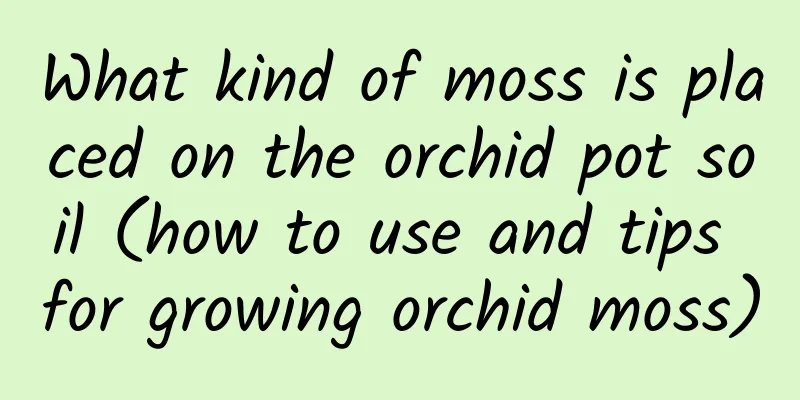What kind of moss is placed on the orchid pot soil (how to use and tips for growing orchid moss)

|
Many orchid lovers, including some bonsai growers, like to plant some mosses on the surface of flower pots. Mosses can play a decorative role in flower pots and increase the ornamental value of flowers. How to use moss correctly when growing orchids? Moss is a good thing for orchids, but if used incorrectly, it can have strong side effects. There are two ways to use moss in orchid cultivation : one is to plant moss on the surface of the pot, which is alive . The other is to spread moss on the surface of the pot, which does not require survival, but only plays a role in protecting the flower buds and moisturizing the surface of the pot . 1. Living mossIt is actually very easy to grow moss on the surface of an orchid pot, because the growth habits of moss are generally similar to those of orchids. They all like a ventilated, humid environment with some scattered sunlight. Mosses require less light than orchids. At this time, the leaves of orchids play a role in shading. Living moss can protect the planting material on the surface of the pot from being washed away when it rains or waters. If there is no moss on the surface of the pot when it rains outdoors, mud may splash and contaminate the leaves, but moss can prevent this contamination . In addition, the roots of moss will secrete acidic substances, which will slowly penetrate into the soil and have a good improvement effect on the alkaline condition of the planting material. Moreover, if the orchid is planted shallowly, the moss can also ensure the humidity of the reed head . However, if the moss grows too vigorously, its length should be trimmed in time to prevent the moss from being higher than the orchid's leaf beetle. 2. Cover with mossThis type of moss is usually used when there are flower buds in autumn. The flower buds of spring orchids and cymbidium orchids need low temperature vernalization, and when the leaves can be fully vernalized, the flower buds may not be able to bear it. Especially for some transplanted orchids, if the position of the flower buds is low (under the potting soil) before transplanting, and the flower buds are directly exposed to the soil surface after planting, their cold resistance will be even worse. At this time, the role of moss is reflected. The flower buds covered with moss are equivalent to adding a layer of anti-freeze net. Even in a short period of sub-zero temperatures, there is no need to worry about the flower buds being frozen . So, if moss is so good, does it have any other disadvantages? In fact, everything has its pros and cons, and usually they complement each other. No matter how you use moss, orchids will have higher requirements for ventilation. In particular, it is recommended to remove the moss after flowering every spring, otherwise it may affect the germination of new buds. Because the planted moss is a living organism and has the ability to breathe, its influence on new shoots is relatively much smaller. Moss treatment methodAnother point that needs special attention is that the moss covered in autumn and winter must be processed before use. Because wild moss will inevitably have some insects, eggs and bacteria. If it is not handled properly, it will cause unnecessary trouble to the orchid next year. My treatment method is very simple. After picking up moss from the wild, I spread it flat on the ground, then spray it with fungicide (I use more carbendazim) and then spray it with imidacloprid once. This can basically remove the pests, eggs and germs carried by the moss. Of course, when choosing moss, pay attention to its growth state. The healthier and more vigorous the moss, the better. For planting moss, after transplanting the orchids in spring, choose the healthiest moss and plant it in several distributed spots on the surface of the orchid pot to allow it to grow better on its own. |
>>: The best time to remove the apple bag (how long after the apple bag can be removed)
Recommend
Disease and Pest Control of Water Spinach
White rust prevention and control methods: ⑴ When...
Difference Between Hollyhock and Mallow
1. Different plant types Hollyhock is a biennial ...
How to make cactus bloom
How to make cactus bloom To promote the flowering...
A flower that symbolizes strength, bravery and independence
1. Cactus It is a plant with very tenacious vital...
These 8 kinds of flowers have a particularly long flowering period, so you can enjoy flowers all year round by growing one in a pot!
Begonia Flowering period: all year round 1. Begon...
What month are cherries in season?
Cherries are a cultivated variety of European swe...
How many acres of land can be planted with 4400 corn seeds (how many corn plants can be planted in one acre of land)
Now is the planting season of summer corn here, t...
What to do if the dripping Guanyin grows too tall
Growth of Dripping Guanyin The weeping angel is a...
How to prune white orchid
When to prune white orchids White jasmine can be ...
Can I put egg shells in the soil of green radish? What kind of soil is best for green radish?
1. Is it possible? When caring for it, you can pu...
Causes and treatments of yellowing leaves of the lotus
1. Insufficient light Reason: The lotus plant lik...
Can a peony survive if its leaves wilt?
1. Can I still live? Peonies are relatively diffi...
Follow the camera to play with succulents and see what expensive goods look like!
raindrop Family: Echeveria of the Crassulaceae fa...
Feng Shui placement of fortune tree
Feng Shui Whether they are business people or ord...
When is the right time to sow autumn beans?
Autumn bean planting time Autumn beans are soybea...









